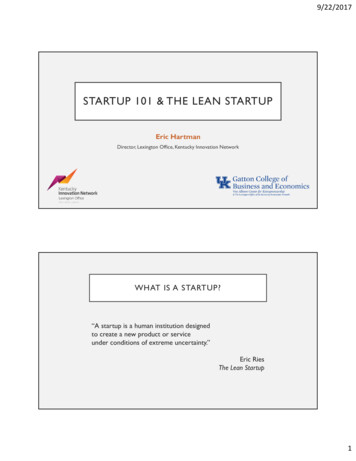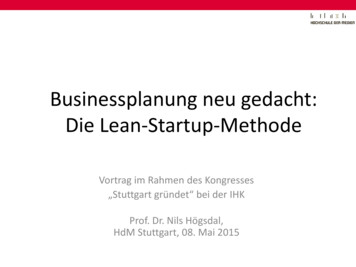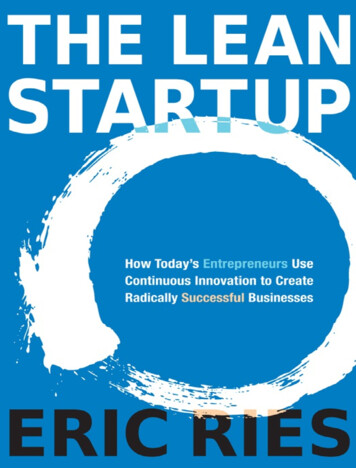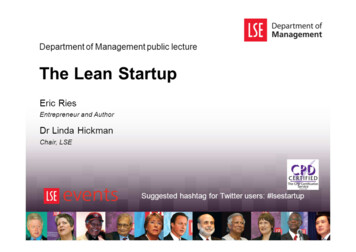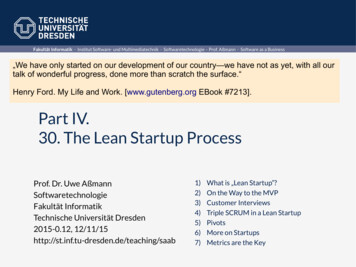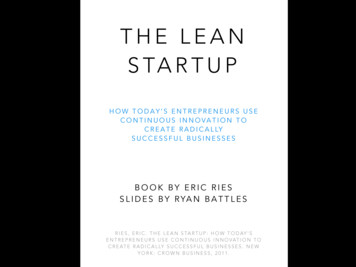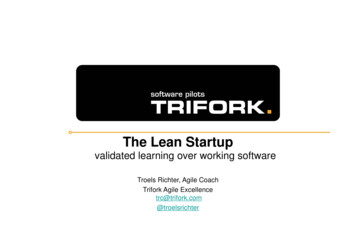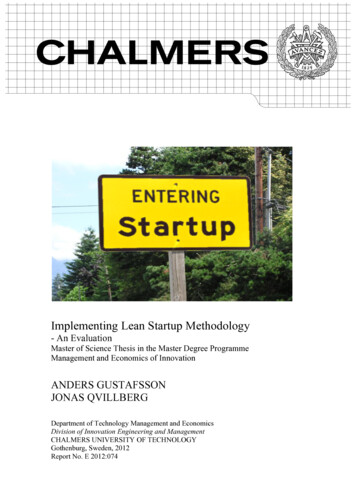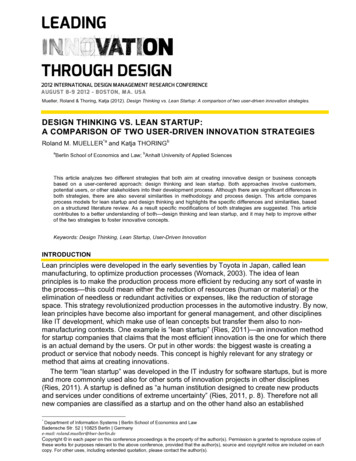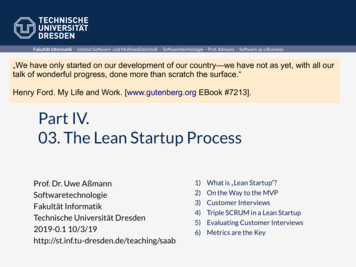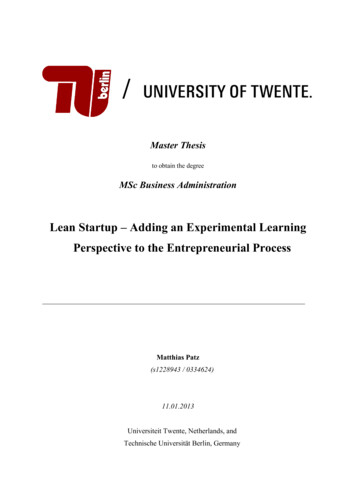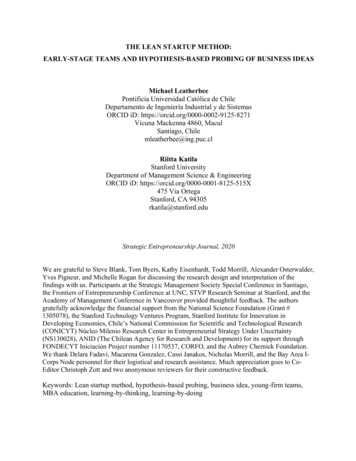
Transcription
THE LEAN STARTUP METHOD:EARLY-STAGE TEAMS AND HYPOTHESIS-BASED PROBING OF BUSINESS IDEASMichael LeatherbeePontificia Universidad Católica de ChileDepartamento de Ingeniería Industrial y de SistemasORCID iD: https://orcid.org/0000-0002-9125-8271Vicuna Mackenna 4860, MaculSantiago, Chilemleatherbee@ing.puc.clRiitta KatilaStanford UniversityDepartment of Management Science & EngineeringORCID iD: https://orcid.org/0000-0001-8125-515X475 Via OrtegaStanford, CA 94305rkatila@stanford.eduStrategic Entrepreneurship Journal, 2020We are grateful to Steve Blank, Tom Byers, Kathy Eisenhardt, Todd Morrill, Alexander Osterwalder,Yves Pigneur, and Michelle Rogan for discussing the research design and interpretation of thefindings with us. Participants at the Strategic Management Society Special Conference in Santiago,the Frontiers of Entrepreneurship Conference at UNC, STVP Research Seminar at Stanford, and theAcademy of Management Conference in Vancouver provided thoughtful feedback. The authorsgratefully acknowledge the financial support from the National Science Foundation (Grant #1305078), the Stanford Technology Ventures Program, Stanford Institute for Innovation inDeveloping Economies, Chile’s National Commission for Scientific and Technological Research(CONICYT) Núcleo Milenio Research Center in Entrepreneurial Strategy Under Uncertainty(NS130028), ANID (The Chilean Agency for Research and Development) for its support throughFONDECYT Iniciación Project number 11170537, CORFO, and the Aubrey Chernick Foundation.We thank Delara Fadavi, Macarena Gonzalez, Cassi Janakos, Nicholas Morrill, and the Bay Area ICorps Node personnel for their logistical and research assistance. Much appreciation goes to CoEditor Christoph Zott and two anonymous reviewers for their constructive feedback.Keywords: Lean startup method, hypothesis-based probing, business idea, young-firm teams,MBA education, learning-by-thinking, learning-by-doing
ABSTRACTResearch summaryWe examine a learning-by-doing methodology for iteration of early-stage business ideas knownas the “lean startup.” The purpose of this paper is to lay out and test the key assumptions of themethod, examining one particularly relevant boundary condition: the composition of the startupteam. Using unique and detailed longitudinal data on 152 NSF-supported lean-startup (I-Corps)teams, we find that the key components of the method—hypothesis formulation, probing, andbusiness idea convergence—link up as expected. We also find that team composition is animportant boundary condition: business-educated (MBA) members resist the use of the method,but appreciate its value ex-post. Formal training in learning-by-thinking methods thus appears tolimit the spread of learning-by-doing methods. In this way, business theory constrains businesspractice.Managerial summaryLean startup methodology has rapidly become one of the most common and trusted innovationand entrepreneurship methods by corporations, startup accelerators, and policymakers.Unfortunately, it has largely been portrayed as a one-size-fits-all solution—its key assumptionssubject to little rigorous empirical testing, and the possibility of critical boundary conditionsignored. Our empirical testing supports the key assumptions of the method, but points to businesseducation of team members as a critical boundary condition. Specifically, MBAs resist the use ofthe method despite being in a strong position to leverage it. Results from a post-hoc analysis weconducted also suggest that more engagement with the method relates to higher performance ofthe firm in the 18-month period following the lean startup intervention.2
We decided our company was a go! We have enough data to support our hypotheses and somegood feedback from potential partners.–NSF I-Corps team, 2016.Bounded rationality—finite information, finite minds, and finite time—makes young firmsimperfect decision-makers (March and Simon, 1958; McGrath and Macmillan, 2009; Hallen andPahnke, 2016). Early-stage teams, especially under high levels of environmental uncertainty andin technology-based industries, are unlikely to decide on an optimal business idea1 from the verybeginning of their ventures (Contigiani and Levinthal, 2018). Too much relevant information ismissing, and capturing it requires time and effort. To address this problem and reduceuncertainty about their businesses’ viability, entrepreneurs are encouraged to iterate theirbusiness ideas using both “learning-by-thinking” and “learning-by-doing” methods that areoutlined in research (Gans, Stern, and Wu, 2019; Ott, Eisenhardt, and Bingham, 2017).Understanding these methods is particularly important because getting the business idea “right”early on can have a high impact in the long run (McDonald and Gao, 2019; Zott and Amit,2007).In the past decade or so, a new learning-by-doing methodology known as the “lean startup”has emerged. The goal is simple: to help early-stage teams iterate business ideas until they areable to make a sound decision about them (Blank, 2003; Ries, 2011). The method’s significantfeatures are (1) formulation of hypotheses in nine pre-identified areas of the business idea (usinga shorthand visualization called canvas) and (2) “getting out of the building” to probe eachhypothesis by interviewing customers and other stakeholders. The expected outcome of thishypothesis-probing process is to converge on a business idea by “confirming” or “disconfirming”1We define “business idea” as startup’s business concept including all the elements that would typically be includedin a business plan (Delmar and Shane, 2003).3
the hypotheses.2Lean startup is a blend of previously identified learning-by-doing methods. It drawsinspiration from previous blended approaches such as discovery-driven planning that similarlyurge teams to articulate their underlying assumptions and to get data to iterate them (McGrathand MacMillan, 1995, 2009), and it builds on some existing principles of experimentation (i.e.,hypotheses and their testing). It is novel, however, in its strong emphasis on interviewingcustomers and in its shorthand visualization of the core components of the business idea(Contigiani and Levinthal, 2018).Lean startup is currently one of the most widely embraced entrepreneurship methods, andit is particularly valuable under environmental uncertainty (Contigiani and Levinthal, 2018; Kerr,Nanda, and Rhodes-Kropf, 2014). Nevertheless, the method’s key assumptions and boundaryconditions have not been subject to rigorous empirical analysis. Addressing this gap will thus bekey to improving the method and to improving business idea processes in general.The boundary conditions in particular require examination. The belief that early-stageteams would promptly revise their ideas in response to market information (e.g., customerinterviews) is in sharp contrast with the description in recent research of some founders asreluctant to change their original ideas, even when external information prescribes it (Parker,2006; Crilly, 2018; Grimes, 2017). In particular, teams deeply steeped in educational expertiseoften resist implementing changes in response to external feedback (Katila and Shane, 2005),2The lean startup method uses the terms “hypothesis testing,” “validation” and “experimentation” in reference tothe process of checking the assumptions underlying the business idea. Throughout this paper we use the term“probing”, as it more accurately reflects what the teams are actually doing, i.e., interviewing customers, but notnecessarily testing or running experiments in a scientifically rigorous way. We also use the term “convergence”rather than validation to clearly differentiate the method from scientific experiments that are not the method’s focus.Convergence is defined as a team’s belief that a particular assumption in the business-model canvas now hasreduced level of uncertainty and is not considered an ongoing hypothesis to test.4
suggesting educational background as a potentially relevant boundary condition.3 A betterunderstanding of team composition is also important because this factor can be adjusted byorganizations directly, providing a clear point of intervention.We examine 152 early-stage teams engaged in a standardized implementation of the leanstartup method over an 8-week period. Our particular research setting is I-Corps—a NationalScience Foundation (NSF) program developed by Steve Blank using the lean startup method,which has been offered in a consistent manner since 2011. During the program, all teams iteratea business idea for a core technology originally created by a scientist (one of the team members)and financially supported by a grant from the National Science Foundation.There are several findings. First, the results from our baseline hypotheses shed light on theunderlying assumptions of the method. Our results confirm the central role of probing (i.e.,customer interviews). Probing not only motivates convergence on a business idea, as the methodpredicts. We discover that it also motivates the formulation of new ideas, with theircorresponding hypotheses-to-be-tested. Probing can thus help teams to dislodge an entrenchedvision of the business idea, as needed, and find a new plan. We also find that if a team convergeson an idea, it is likely to formulate fewer new hypotheses, which suggests that the methodinvolves a natural stopping mechanism.4 In contrast, we do not find confirmation for the centralrole of hypothesis formulation: formulating a large number of hypotheses does not drive or helpteams’ probing. Altogether, we find support for the main assumptions of the method, but we notethat one criticism—that endless formulation of new hypotheses may tire out entrepreneurs and3Parker (2006), for example, found that older entrepreneurs were less willing to change business ideas even whenexternal feedback suggests otherwise, but there is very little evidence about team expertise and “learning-by-doing”methods in general.4These findings are particularly interesting given prior literature’s critique of the method that probing leadsentrepreneurs to change ideas too frequently, become disheartened and give up (Ladd, 2016); or converge towardsbusiness ideas that are bounded by customers’ explicit feedback, and thus obvious in nature (Felin et al., 2019).5
prevent scaling (Ladd, 2016)—is indeed correct, highlighting the dangers of hypothesisproliferation as an end in itself.Second, we identify boundary conditions for the method. While it is beyond the scope ofthis study to examine all possible boundary conditions, our findings clearly show theirimportance for the method and its results. In particular, we find that certain teams embrace themethod, while others tend to resist it. In particular, teams with formal business education (i.e.,MBAs on the team) are the least likely to formulate hypotheses and to converge on a businessidea. We suggest that this is because learning-by-thinking, which is the staple of MBA programs,can limit the appreciation of learning-by-doing methods like lean startup. However, compared toteams with no business education, MBA teams who do engage in hypothesis probing alsoformulate more new business ideas and their corresponding hypotheses and achieve ideaconvergence faster. MBAs thus may be particularly apt at some components (such as interpretingdata from probing) if they engage with the method in the first place.RESEARCH BACKGROUNDPrior research outlines two main approaches—learning-by-thinking and learning-by-doing—thatearly-stage teams can use to iterate their business ideas (Gans et al., 2019; Ott et al., 2017).Iteration by learning-by-thinking, that is, thinking through potential consequences for alternativefirm actions before choosing, received much early attention (e.g., Delmar and Shane, 2003;Gavetti, Levinthal, and Rivkin, 2005). Recently, scholarly attention has shifted to learning-bydoing, in other words, trying potential alternatives before choosing, most notably categorized astrial-and-error, bricolage, and experimentation approaches. Table 1 summarizes the differencesbetween the two learning approaches and their relation to the lean startup method.Learning-by-thinking methods use mental representations of the environment to plan how a6
firm’s solutions address problems. A “cognitive structures” approach, for example, suggests thatearly teams form better strategies when they have a holistic understanding of opportunities,markets, and their own firms, and think through the potential consequences for alternative firmactions before choosing (Felin and Zenger, 2009; Ott et al., 2017). An exemplar is Delmar andShane’s (2003) study of a random sample of 223 Swedish ventures, which finds that ventureswith a holistic business plan are more likely to introduce products and less likely to fail.“Analogies,” in turn, are mental representations of past solutions used to solve current problems.The case teaching approach common in business schools is an example. Although the leanstartup features a blueprint of the environment (i.e., nine areas visualized in the canvas), ingeneral it shares very few similarities with learning-by-thinking methods (see Table 1).Learning-by-doing methods, in contrast, are based on taking action and learning fromexperience. There are three primary approaches: trial-and-error, bricolage, and experiment. Intrial-and-error, many ideas are tried (typically in the neighborhood of existing good solutions) inthe hopes of stumbling upon a promising one (Bingham and Davis, 2012; Katila and Ahuja,2002). An analogy may be made to evolutionary theory, where rounds of variation and selectionproduce adaptive results over time—although trial-and-error is less “blind” than natural selectionis. Callander (2011) says, “Trial and error search begins where theory insight ends but is notblind as agents are using experience—accumulated information from successes and failures—toguide f
Lean startup is a blend of previously identified learning-by-doing methods. It draws inspiration from previous blended approaches such as discovery-driven planning that similarly urge teams to articulate their underlying assumptions and to get data to iterate them (McGrath
